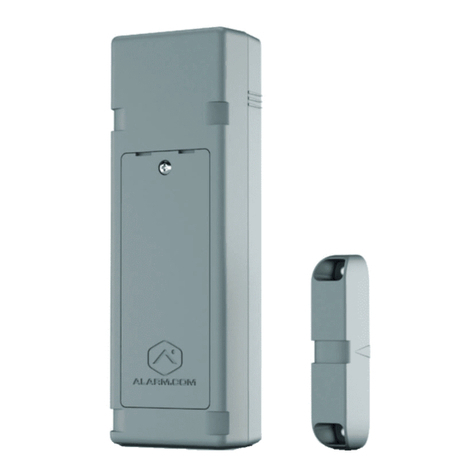
4. Tap oolbox.
5. Enter the installer code.
6. Tap Installer oolbox.
7. Tap System Configuration.
Note: In System Configuration, tap the ←or →arrows to scroll between options for the current setting, and tap
the ↑or ↓arrows to move to the previous or next programming prompt.
8. Under Q1, select the RF sensor # (01 to 48) to assign the Image Sensor to an empty, unused sensor number.
9. Select the RF sensor type. The recommended groups for an Image Sensor are (04) Interior Follower, (10) Interior
w/ Delay, or (23) No Response Type. For more information about sensor groups, see 2GIG GC2e Sensor Groups.
10. Select RF sensor equipment type. Tap 2for Motion.
11. Select RF sensor equipment code. Tap 9999 for ADC Image Sensor.
12. Register the RF sensor serial Number:
a. Tap Learn to initiate learn mode on the panel and XCVR2 radio.
b. Power up the Image Sensor by inserting the batteries.
c. Use a paper clip to hold the sensor’s reset button for at least 10 seconds until the LED flashes rapidly for
more than two seconds. The reset button must be held for at least a full 10 seconds.
Note: A 1-second fast blink may occur during the reset attempt. This indicates that the sensor is not enrolled
in a network.
d. The panel indicates when the Image Sensor is successfully enrolled.
13. Select RF sensor equipment age.
◦ If the Image Sensor is new, tap 0for New.
◦ If the Image Sensor is an existing device, tap 1for Existing.
14. Select RF sensor loop number. The recommended is Loop 1.
15. Select RF sensor dialer delay.
◦ To disable the dialer delay, tap 0for Disabled.
◦ To enable the dialer delay, tap 1for Enabled.
16. Construct RF sensor voice descriptor. Tap Insert, and then scroll or enter a number (002 - 255) to add a word.
◦ For example, for Front IS Motion Detector, tap Insert and then tap 098 for Front. Tap Insert again, and then
tap 120 for IS. Tap Insert again, and then tap 147 for Motion Detector. Tap ↓to continue configuring the
sensor. For a full list of voice descriptors, see page 2 of the 2GIG GoControl Installation Guide - Quick
Programming Guide.
17. Select RF sensor reports. The recommended is (1) Enabled to enable sensor reports.
18. Select RF sensor supervised. The recommended is (1) Enabled to enable reports for loss of supervision.
19. Select RF sensor chime (0 to 13).
◦ To disable the panel chime when the sensor is activated, tap 0for Disabled.
◦ To select a voice and chime to sound when the sensor is activated, enter a number from 1through 13 to
enable the chime.
20. To program another sensor, tap Next.
https://answers.alarm.com/Partner/Installation_and_Troubleshooting/Image_Sensor/Image_Sensor_Version_3/2GIG_GC2e_I…
Updated: Fri, 10 Mar 2023 20:17:16 GMT
4































